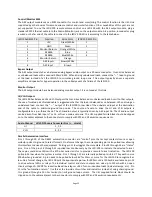
Page 56
Appendix B – Automation Commands
These commands are used to query the status of the JSD-100 or change its operation (adjust level, select input,
etc.). The commands are typically sent by an automation system. They may be sent over RS-232 or Ethernet. This
is a subset of the full command set. The full command set includes commands for adjust equalization, etc.
Commands are not echoed by the JSD-100. Commands are terminated by a carriage return (0x0d). Commands are
tab delimited. There needs to be a tab character (0x09) between the command and the first parameter, then
another tab before the second parameter, etc. The JSD-100 responds to every command. Responses are also tab
delimited and are terminated with a carriage return. All commands are lower case and are case sensitive. Note:
Every command generates some sort of response that must be picked up by the command sender. Failure to pick
up these responses can cause buffers in the JSD-100 or the host to fill, possibly halting communications. If the
response is not needed, a simple "eat garbage" routine that loops until the receive buffer is empty should be called
before sending a command.
RS-232
The JSD-100 is a DCE device that transmits on pin 2 of the 9 pin D connector. The JSD-100 receives data on pin 3.
Communications is at 38.4kbps, 8N1 (8 databits, no parity, 1 stop bit).
Ethernet
The JSD-100 listens on port 10001 for TCP connections from other equipment (typically a digital cinema server).
Commands and responses are then exchanged in ASCII.
Automation Command List
The Automation Command List shown in table below. For simplicity, tab and carriage return characters are not
shown. Remember that commands are tab delimited and terminated with a carriage return. In the table below,
the required tab characters are shown as "\t", and the required carriage return characters are shown as "\r".
Consult the next table to determine how to insert a tab or carriage return in the command string.
Command
Response
Description
jsd100.sys.fader\t700\r
700
Sets or reads the current fader level. If a parameter is provided, the
main fader is set to the corresponding level. The parameter is the
fader level times 100. In this example, the fader is set to 7.0. If no
parameter is supplied, the fader level is not changed. The command
always returns the current fader level times 100. If the command
changed the fader level, the new level is returned.
jsd100.sys.fader_rel\t-50\r
-50
Makes a relative adjustment to the current fader level. The
parameter is the relative adjustment times 100. In the example,
the fader level was decreased by 0.5 (perhaps from 7.0 to 6.5). The
relative adjustment that was made is returned.
jsd100.sys.input_mode\t4\r
4
Selects or reads the input format. If a parameter is supplied, the
JSD-100 is switched to this input. In the example, input mode 4,
corresponding to button 4 on the front panel (Digital 16 Channel) is
selected. If no parameter is supplied, no change is made to the
current input mode. The command always returns the currently
selected input mode. If a parameter was provided, the new input
mode is returned. If no parameter was provided, the currently
selected input mode is returned.












































